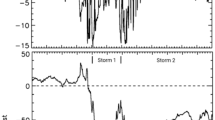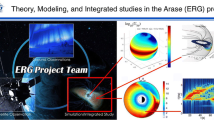Abstract
The THEMIS mission provides unprecedented multi-point observations of the magnetosphere in conjunction with an equally unprecedented dense network of ground measurements. However, coverage of the magnetosphere is still sparse. In order to tie together the THEMIS observations and to understand the data better, we will use the Open Geospace General Circulation Model (OpenGGCM), a global model of the magnetosphere-ionosphere system. OpenGGCM solves the magnetohydrodynamic (MHD) equations in the outer magnetosphere and couples via field aligned current (FAC), electric potential, and electron precipitation to a ionosphere potential solver and the Coupled Thermosphere Ionosphere Model (CTIM). The OpenGGCM thus provides a global comprehensive view of the magnetosphere-ionosphere system. An OpenGGCM simulation of one of the first substorms observed by THEMIS on 23 March 2007 shows that the OpenGGCM reproduces the observed substorm signatures very well, thus laying the groundwork for future use of the OpenGGCM to aid in understanding THEMIS data and ultimately contributing to a comprehensive model of the substorm process.
Similar content being viewed by others
References
S.-I. Akasofu, The development of the auroral substorm. Planet. Space Sci. 12, 273 (1964)
S.-I. Akasofu, Physics of Magnetospheric Substorms (Reidel, Dordrecht, 1977)
V. Angelopoulos, The THEMIS mission. Space Sci. Rev. (2008, this issue). doi:10.1007/s11214-008-9336-1
V. Angelopoulos et al., First results from the THEMIS mission. Space Sci. Rev. (2008, this issue). doi:10.1007/s11214-008-9378-4
D.N. Baker, T.I. Pulkkinen, J. Büchner, A.J. Klimas, Substorms: A global instability of the magnetosphere-ionosphere system. J. Geophys. Res. 104, 14,601 (1999)
J.U. Brackbill, D.C. Barnes, The effect of nonzero div B on the numerical solution of the magnetohydrodynamic equations. J. Comput. Phys. 35, 426 (1980)
B.A. Emery et al., Comparing POLAR UVI imager data and other conductance sources in AMIE. Eos Trans. AGU 77(46), 613 (1996)
C.R. Evans, J.F. Hawley, Simulation of magnetohydrodynamic flows: A constrained transport method. Astrophys. J. 332, 659 (1988)
D.H. Fairfield, Advances in magnetospheric storm and substorm research: 1989–1991. J. Geophys. Res. 97, 10,865 (1992)
J.A. Fedder, J.G. Lyon, The solar wind-magnetosphere-ionosphere current-voltage relationship. Geophys. Res. Lett. 14, 880 (1987)
J.A. Fedder, S.P. Slinker, J.G. Lyon, R.D. Elphinstone, Global numerical simulation of the growth phase and the expansion onset for a substorm observed by Viking. J. Geophys. Res. 100, 19,083 (1995)
T.J. Fuller-Rowell, D. Rees, S. Quegan, R.J. Moffett, M.V. Codrescu, G.H. Millward, A coupled thermosphere-ionosphere model (CTIM), in STEP Report, ed. by R.W. Schunk (Scientific Committee on Solar Terrestrial Physics (SCOSTEP), NOAA/NGDC, Boulder, 1996), p. 217
G.A. Germany, G.K. Parks, M. Brittnacher, J. Cumnock, D. Lummerzheim, J.F. Spann, L. Chen, P.G. Richards, F.J. Rich, Remote determination of auroral energy characteristics during substorm activity. Geophys. Res. Lett. 24, 995 (1997)
A. Harten, G. Zwas, Self-adjusting hybrid schemes for shock computations. J. Comput. Phys. 9, 568 (1972)
C. Hirsch, Numerical Computation of Internal and External Flow, vol. II (Wiley, New York, 1990)
A. Keiling et al., Correlation of substorm injections, auroral modulations, and ground Pi2. Geophys. Res. Lett. 35, L17S22 (2008). doi:10.1029/2008GL033969
M.C. Kelley, The Earth’s Ionosphere (Academic Press, New York, 1989)
C.F. Kennel, The Kiruna conjecture: The strong version, in Substorms I, vol. SP-335 (ESA, Noordwijk, 1992), p. 599
S. Knight, Parallel electric fields. Planet. Space Sci. 21, 741 (1972)
C.B. Laney, Computational Gasdynamics (Cambridge University Press, Cambridge, 1998)
A.T.Y. Lui, Extended consideration of a synthesis model for magnetic substorms, in Magnetospheric Substorms, ed. by J.R. Kan, T.A. Potemra, S. Kokubun, T. Ijima. AGU Geophys. Monogr. Ser., vol. 64 (American Geophysical Union, Washington, 1991), p. 43
D. Lummerzheim, M. Brittnacher, D. Evans, G.A. Germany, G.K. Parks, M.H. Rees, J.F. Spann, High time resolution study of the hemispheric power carried by energetic electrons into the ionosphere during the May 19/20, 1996 auroral activity. Geophys. Res. Lett. 24, 987 (1997)
R.L. McPherron, Physical processes producing magnetospheric substorms and magnetic storms, in Geomagnetism, vol. 4, ed. by J. Jacobs (Academic Press, New York, 1991), p. 593
J. Raeder, Global magnetohydrodynamics—A tutorial, in Space Plasma Simulation, ed. by J. Büchner, C.T. Dum, M. Scholer (Springer, Berlin, 2003)
J. Raeder, N. Maynard, Foreword. J. Geophys. Res. 106, 345 (2001)
J. Raeder, J. Berchem, M. Ashour-Abdalla, The importance of small scale processes in global MHD simulations: Some numerical experiments, in The Physics of Space Plasmas, vol. 14, ed. by T. Chang, J.R. Jasperse (MIT Cent. for Theoret. Geo/Cosmo Plasma Phys., Cambridge, 1996), p. 403
J. Raeder, Y.L. Wang, T. Fuller-Rowell, Geomagnetic storm simulation with a coupled magnetosphere—ionosphere—thermosphere model, in Space Weather, ed. by P. Song, G. Siscoe, H.J. Singer. AGU Geophys. Monogr. Ser., vol. 125 (American Geophysical Union, Washington, 2001a), p. 377
J. Raeder et al., Global simulation of the geospace environment modeling substorm challenge event. J. Geophys. Res. 106, 381 (2001b)
H. Rishbeth, W. Deng, R.G. Roble, T.L. Killeen, A.G. Burns, The flywheel effect: ionospheric currents after a geomagnetic storm. Geophys. Res. Lett. 18, 1845 (1991)
C.T. Russell, Y.L. Wang, J. Raeder, The interplanetary shock of September 24, 1998: Arrival at Earth. J. Geophys. Res. 105, 25,143 (2001)
D.G. Sibeck, V. Angelopoulos, THEMIS science objectives and mission phases. Space Sci. Rev. (2008, this issue). doi:10.1007/s11214-008-9393-5
S.P. Slinker, J.A. Fedder, J.G. Lyon, Plasmoid formation and evolution in a numerical simulation of a substorm. Geophys. Res. Lett. 22, 859 (1995)
B.U.O. Sonnerup, L.J. Cahill, Magnetopause structure and attitude from Explorer 12 observations. J. Geophys. Res. 72, 171 (1967)
B.U.O. Sonnerup, L.J. Cahill, Explorer 12 observations of the magnetopause current layer. J. Geophys. Res. 73, 1757 (1968)
R.J. Strangeway, J. Raeder, On the transition from collisionless to collisional magnetohydrodynamics. J. Geophys. Res. 106, 1955 (2001)
G. Toth, The ∇⋅B constraint in shock-capturing magnetohydrodynamics codes. J. Comput. Phys. 161, 605 (2000)
E.R. Tufte, Envisioning Information (Graphics Press, Cheshire, 1990)
V.M. Vasyliunas, Mathematical models of magnetospheric convection and its coupling to the ionosphere, in Particles and Fields in the Magnetosphere (Dordrecht, Reidel, 1970), p. 61
M. Wiltberger, T.I. Pulkkinen, J.G. Lyon, C.C. Goodrich, MHD simulation of the magnetotail during the December 10, 1996, substorm. J. Geophys. Res. 105, 27,649 (2000)
S.T. Zalesak, Fully multidimensional flux-corrected transport. J. Comput. Phys. 31, 355 (1979)
S.T. Zalesak, Very high order pseudospectral flux-corrected transport (FCT) algorithms for conservation laws, in Proceedings of the Fourth IMACS International Symposium on Computer Methods for Partial Differential Equations, ed. by R. Vichnevetsky, R.S. Stepleman (IMACS, Rutgers University, New Brunswick, 1981), p. 126
Author information
Authors and Affiliations
Corresponding author
Rights and permissions
About this article
Cite this article
Raeder, J., Larson, D., Li, W. et al. OpenGGCM Simulations for the THEMIS Mission. Space Sci Rev 141, 535–555 (2008). https://doi.org/10.1007/s11214-008-9421-5
Received:
Accepted:
Published:
Issue Date:
DOI: https://doi.org/10.1007/s11214-008-9421-5




